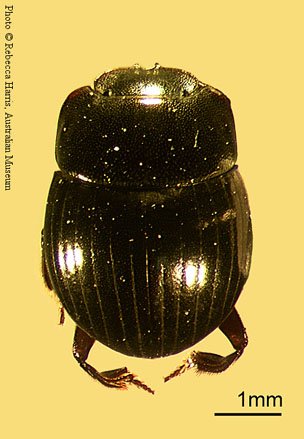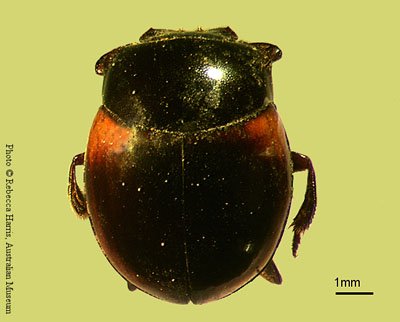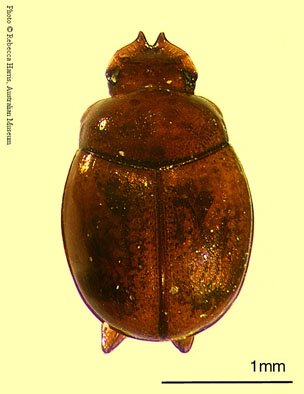![]()
![]()
![]()
Genus Lepanus



Species found in eastern NSW: L. australis, L. bidentatus, L. illawarrensis, L. politus, L. ustulatus.
Other species: L. dichrous, L. furcifer, L. globulus, L. latheticus, L. monteithi, L. nitidus, L. palumensis, L. parapisoniae, L. pisoniae, L. vestitus, L. villosus (Qld)
L. occidentalis (WA)
L. pygmaeus (Qld, WA)
Distribution
Australia and New Guinea. In Australia, occurs mostly along the east coast, from Victoria to Cape York. Two species occur in Western Australia.
Description
Small (1.6-6.5mm), broadly oval, moderately to very convex. Colour usually uniformly reddish or black, very shiny and hairless, but some species may have lighter areas, or matt surfaces. No tubercles or keels on pronotum or elytra.
2 small clypeal teeth, separated by a rounded space. Anterior part of underside of pronotum deeply excavated.
Elytra: elytra with 8 striae, without pseudepipleura or keels. Intervals of striae flat.
Hind wings: Fully developed, or occasionally absent.
Legs: Outer edge of fore tibiae with 2 or 3 small acute teeth, rest of edge finely serrated. Middle coxae moderately convergent. Middle and hind tibiae with very short spurs. Claws subdentate.
Abdomen: Pygidium with complete margin, often with a median depression or groove, or basal fold.
Sexual dimorphism
Male with a prolonged process on the inner apical angle of fore tibiae and fore spur reduced. Process absent or shorter in female, the fore spur larger. Male may have modified middle tibiae and a small tubercle on metasternum. Pygidium of male proportionately a little longer than female.
Similar Genera
Aptenocanthon, of a similar size and general shape (some species), two small clypeal teeth.
Obvious differences: Aptenocanthon a uniform black colour, with simple claws and pseudepipleura outside 7th striae.
Ecology
Adults coprophagous, with flightless and winged species, in closed forest, open forest, tall open forest, mountain slopes, and open areas.
Notes
At least three undescribed species occur in eastern New South Wales, each distinguished by structure of the pygidium.
References
Cassis, G. & Weir, T.A. (1992) Scarabaeinae. pp 106-173. In: Houston, W.W.K. (ed.) Zoological Catalogue of Australia. Coleoptera: Scarabaeoidea. Canberra: AGPS Vol. 9.
Matthews, E.G. (1974) A revision of the Scarabaeine dung beetles of Australia. II. Tribe Scarabaeini. Aust. J. Zool. Suppl. Ser. 24: 1-211.
